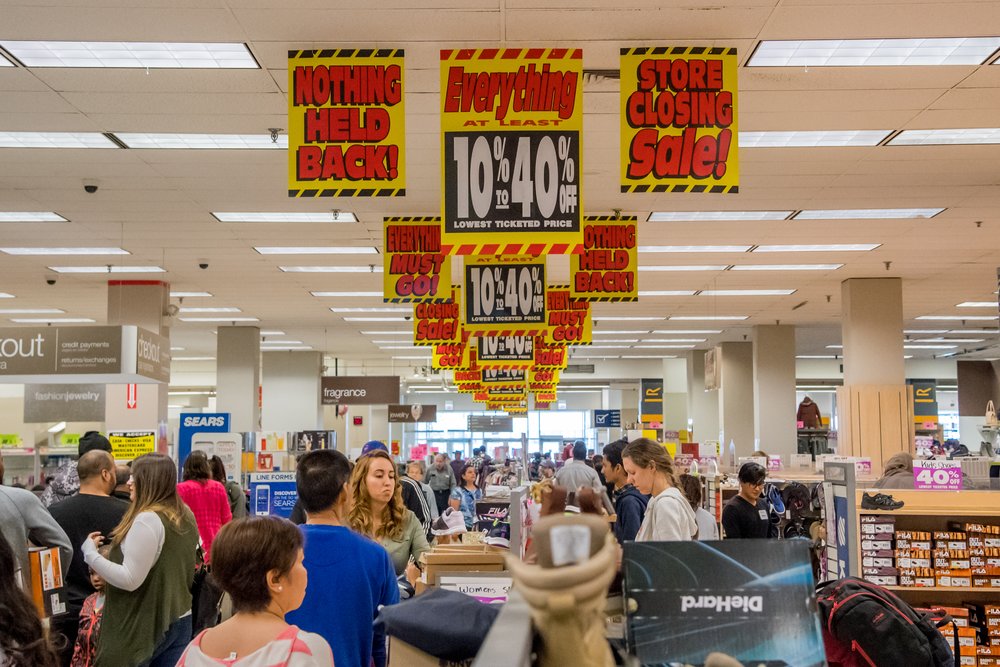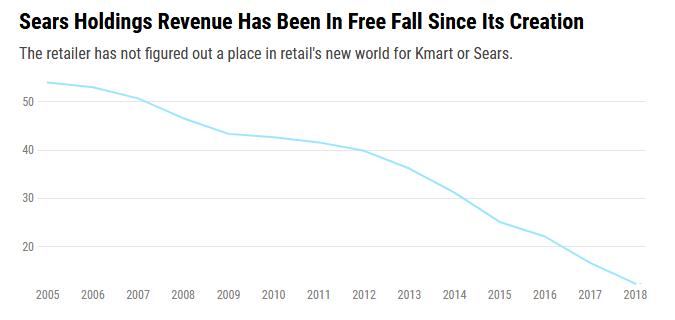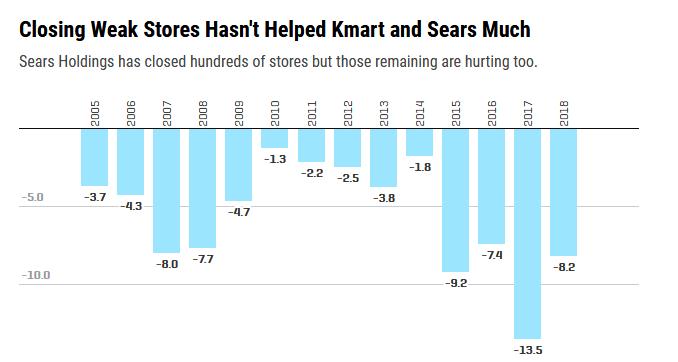别怪亚马逊,零售巨头西尔斯轰然倒下只能怪自己

|
据《华尔街日报》报道,西尔斯控股已经聘请顾问,可能按照美国破产法第11章递交破产申请。即使是不了解零售业的人,听到消息也会感到吃惊。 如今的西尔斯控股是两大美国零售业巨头西尔斯和Kmart合并的产物,已然负债累累。2004年,前对冲基金大王艾迪·莱姆伯特撮合两家公司合并,却显然欠考虑。合并后的西尔斯业绩连年萎靡,既未能在零售业的新领域立足,也没能通过投资实体店和商品提振经营。 上周,西尔斯有高达1.34亿美元债务到期。公司一度股价跌至0.44美元,仅仅12年前股价还曾触及145美元高点。西尔斯未对破产保护申请的可能性置评。但上周该公司董事会的确增加了一名拥有企业重组经验的董事。 2013年,西尔斯的首席执行官走马灯一般更迭后,终于确定由莱姆伯特接任。过去几年,他为了还债出售公司很多优质业务,包括业绩最好的一些门店、Lands’ End和Craftsman之类知名品牌、(去年清算的)遍布加拿大的庞大百货公司网。事实证明,不管是大甩卖,还是莱姆伯特旗下对冲基金提供的大笔贷款,都很难阻止西尔斯走向末路。而且出售业务无异于饮鸩止渴,西尔斯还失去了有机会在竞争中脱颖而出的特色。毕竟,零售商玩资本运作几时有过好结果? 尽管十年里关闭了几百家门店,西尔斯和Kmart仍然每况愈下,近年来同店销售持续下滑。事实上,从2005年开始,希尔斯控股已经不再公布单一年份的销售和同店(剔除新开张或关闭门店影响)销售增长数据。2011年年初以来,该公司累计净亏损112亿美元。随着西尔斯的业务越变越少,业绩也日渐惨淡,重拾昔日荣光的机会也逐渐渺茫。2015年,公司年营业收入还有540亿美元,而到了2018年,华尔街预计其年收入仅有124亿美元。 |
The Wall Street Journal report published late Tuesday saying Sears Holdings (shld, -23.19%) has hired advisers ahead of a potential Chapter 11 bankruptcy filing this week came as a surprise to no one following the retail industry even remotely closely. The company, a debt-laden retail Frankenstein begat from the ill-advised merger of Kmart and Sears engineered in 2004 by former hedge fund king Eddie Lampert, has been withering for years, unable to find a place for itself in retail’s new world or help itself by investing in its stores and merchandise. Sears, which has $134 million in debt coming due last week, saw shares plummet to $0.44; shares were at $145 at the company’s peak only 12 years ago. The company did not respond to a request for comment on the prospect of a bankruptcy protection filing, but last week the company did add a board member with corporate restructuring experience. To keep Sears solvent in the last few years, Lampert, who became CEO in 2013 after endless turnover in the corner office, has sold off many of Sears’ crown jewels, including its best stores, brands like Lands’ End and Craftsman, and its once-large Canadian unit (which liquidated last year). Those, along with quite a few loans Lampert has made via his hedge fund, have proven to be temporary salves to keep Sears from going under. But ultimately, they hurt the retailer by depriving it of the very features that helped it stand out from rivals. After all, since when has financial engineering ever made a retailer more attractive? Despite closing hundreds of stores this decade, Sears and Kmart both continued to deteriorate, with same-store declines worsening in the last few years. In fact since 2005, Sears Holdings has not reported a single year of sales or comparable sales (which strip out the impact of newly closed or opened stores) growth. The company has rung up $11.2 billion in cumulative net losses since the start of 2011. So much for a leaner and meaner Sears getting its mojo back. In 2015, Sears Holdings had annual revenue of $54 billion. For 2018, Wall Street expects it to come in at $12.4 billion. |


|
慢性恶化的根源在哪里?首先,西尔斯没能吸引购物者不断上门,Kmart也没有。谁能想到,就在三十年前,Kmart曾是比沃尔玛更大的零售商。西尔斯旗下太多的门店非常陈旧,与此同时,塔吉特、沃尔玛和(夺走西尔斯众多家电业务份额的)家得宝都在门店和技术方面投入巨资。西尔斯当年在商品目录销售领域称霸一时,本可以在电子商务的战场上取胜,却抛弃了优势。在开拓商品业务方面,西尔斯远没有竞争对手积极主动:除了几年前因销售不佳而撤柜的金·卡戴珊自创时装品牌Kardashian Kollection,谁还记得西尔斯出售过哪些牌子的服装? 莱姆伯特承诺的改进迟迟未落实,他坚持将西尔斯改造成会员制零售商,努力打造会员项目ShopYourWay。按照这种路线,西尔斯需要的门店越来越少,规模也越来越小。但西尔斯至今也未出现销售业绩和利润强劲增长,谁会相信申请破产后,西尔斯能靠这种方式打翻身仗?虽然也曾有一些不错的尝试,比如为具体家电开设小门店,以及和亚马逊合作,但显然无力扭转命运。 多年来,莱姆伯特还不断为业绩不佳找借口(2005年和去年都归咎于媒体),最近怪起零售业大环境艰难。可今年却是消费者支出最为强劲的年份,强词夺理的借口实在没法让人信服。 莱姆伯特在2006年的致股东信中暗示,希望通过收缩业务规模恢复西尔斯的经营状况:“如果门店的财务状况良好且保持盈利,降低销售并无裨益,但如果盈利不是主要目标,销售主要来自分发产品而非直接向客户提供价值,缩减销售就有望实现经营成功。” 但是,问题就在这里:自从进入新时代,百年零售品牌西尔斯就未真正实现向客户提供价值。(财富中文网) 译者:Pessy 审校:夏林 |
What’s behind this chronic deterioration? Sears never gave shoppers a reason to keep going there, nor did Kmart, which incredibly was a larger retailer than Walmart only 30 years ago. The company also let too many stores fall into disrepair even as companies like Target, Walmart, and Home Depot (to which Sears has lost a lot of its appliance business) have invested heavily in their stores and the technology they use in them. With its once dominant catalog business, Sears had what it needed to win the e-commerce wars. Talk about throwing away a big lead. On the merchandise side, Sears has not been nearly as active as its rivals have: Other than the ill-fated Kardashian Kollection a few years ago, who remembers any Sears apparel? Lampert, who has long been promising improvements that have failed to materialize, has stuck to the line that Sears was reinventing itself as a membership-based retailer focused on its ShopYourWay loyalty program, therefore needing fewer and smaller locations. But those haven’t led to stronger sales or earnings results yet, so what’s the case for believing they’d help a post-bankruptcy Sears? The company has made some good moves, including launching some smaller-format appliance-specific stores as well as teaming up with Amazon. But those are clearly not moving the needle. Indeed, Lampert has trotted out countless excuses (including blaming the media last year and also in 2005) for years, most recently naming a difficult retail environment, a my-dog-ate-my-homework-caliber excuse that doesn’t wash in the most robust consumer spending environment in years. He hinted at shrinking Sears back to health in a 2006 letter to shareholders: “While reducing sales is not a prescription for success on a base of healthy, profitable stores, it can be a prescription for success where profit was not the primary objective and where sales came from ‘giving product away’ rather than from providing value to the customer.” But therein lies the rub: Sears in the modern era has never truly found a way to provide value to its customers in a competitive way. |













